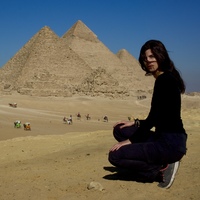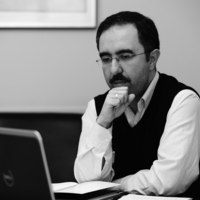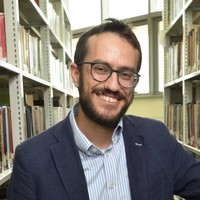Journal Articles by Sara Abram

Studia graeco-arabica, 2023
This article presents an edition and translation of the Treatise on the Immortality of the Ration... more This article presents an edition and translation of the Treatise on the Immortality of the Rational Soul of Man According to Aristotle’s Opinion (M. fī baqāʾ al-nafs al-nāṭiqa min al-insān ʿalā raʾy Arisṭūṭālis) by the Christian philosopher and physician Abū al-Ḫayr al-Ḥasan ibn Suwār (942-post 1017). Its importance lies in the fact that: (i.) it provides the sole testimony concerning the doctrine of the immortality of the soul developed by a philosopher who was a significant representative of the intellectual and exegetical life of his day; (ii.) it constitutes concrete evidence of the fact that the philosophical activity of the Baghdad Aristotelians did not concern only Aristotle’s logic, physics, and metaphysics, but also psychology and noetics; and (iii.) it transmits literal quotations from lost Arabic translations, representing their earliest testimony: three lemmata from Aristotle’s De anima and one from Alexander of Aphrodisias’ De anima in Isḥāq ibn Ḥunayn’s (830-911) translations.
Medioevo. Rivista di storia della filosofia medievale, 2020
This article offers the introduction, the Italian translation and the commentary of the Notes on ... more This article offers the introduction, the Italian translation and the commentary of the Notes on Admissible and Inadmissible Astrological Judgements (Nukat fī mā yaṣiḥḥu wa-mā lā yaṣiḥḥu min aḥkām al-nuǧūm) by Abū Naṣr al-Fārābī (d. 950). It was not transmitted directly by its author, and did not reach us in its definitive version but only in the form of notes copied by a grammarian named Abū Isḥāq al-Baġdādī. In thirty short chapters al-Fārābī writes down what is accessible and what is inaccessible to astrological predictions, which elements of this science should be accepted, and which ones are to be rejected.
Book Chapters by Sara Abram

Introduzione, in al-Fārābī, L’uno e l’unità. Introduzione, testo arabo, traduzione e commento di C. Martini Bonadeo con S. Abram, L. Farina, G. Mandolino, M. Zarantonello. Pisa: Pisa University Press 2023 (Greco, Arabo, Latino. Le vie del sapere. Testi 6), pp. 1-13.
“L’uno è detto in molti modi”. Così inizia in medias res il breve trattato Sull’uno e sull’unità ... more “L’uno è detto in molti modi”. Così inizia in medias res il breve trattato Sull’uno e sull’unità in cui al-Fārābī, sul modello di Aristotele in Metafisica Delta 6 e Iota 1 e 6, presenta una disamina linguistica della polisemia dei termini ‘uno’ e ‘molteplice’. La riflessione che vi presenta è cruciale per la comprensione non solo del pensiero logico del filosofo, ma anche della sua riflessione metafisica. Secondo al-Fārābī, infatti, soggetto primo della metafisica, intesa come scienza universale, è ciò che è comune a tutti gli enti: l’essere e l’uno e i loro contrari, il non-essere e la molteplicità. Unità ed essere, sono coestensivi, massimamente universali, e pericolosamente equivoci. Nel volume questo difficile e ingiustamente dimenticato trattato di al-Fārābī è rivisto criticamente, tradotto e commentato.

Averroè (Ibn Rušd), in: L’analogia dell’essere. Testi antichi e medievali, a cura di Giovanni Catapano, Cecilia Martini Bonadeo, Rita Salis, Padova University Press, Padova, 2020
La presente sezione antologica si propone non solo di accostare alcuni importanti passi di Averro... more La presente sezione antologica si propone non solo di accostare alcuni importanti passi di Averroè riguardanti l’analogia – da lui differentemente espressa con i termini tanāsub, tartīb wa tanāsub, munāsaba e con le perifrasi ašyāʾ mansūba ilā šayʾ wāḥid (in relazione a un’unica cosa) oppure ilā ṭibāʿ wāḥid (a un’unica natura) – ma anche di rispecchiare, almeno parzialmente, l’evoluzione esegetica del filosofo di Cordova nei suoi commenti alla Metafisica di Aristotele. Si tratta, infatti, di estratti (T48 e T49) provenienti dalla giovanile Epitome della Metafisica (c. 1160) e di un passo (T50) dall’ultima opera scritta prima di morire: il Commento grande alla Metafisica (tra il 1192 e il 1194). Seguono, prima della sintesi dei contenuti dei passi in traduzione, un’introduzione all’autore e alla fase esegetica cui appartengono i testi proposti.

La dottrina dell’analogia dell’essere nella « Metafisica » di Aristotele e i suoi sviluppi nel pensiero tardo-antico e medievale, a cura di R. Salis, (Subsidia Mediaevalia Patavina, 14), Il Poligrafo, Padova, 2019
The present paper aims to analyse a lesson, held by the Muslim philosopher Abū Sulaymān al-Siǧist... more The present paper aims to analyse a lesson, held by the Muslim philosopher Abū Sulaymān al-Siǧistānī (d. 985), about the equivocal term ‘one’ and its definitions as conveyed by the man of letters Abū Ḥayyān al-Tawḥīdī (d. 1023) in his muqābasa 82. In particular, it aims to stress the Aristotelian and Neoplatonic roots of al-Siǧistānī’s doctrines and the links they intertwined with the almost contemporary philosophical debates. The muqābasa is organised in two different sections. In the first part, al-Siǧistānī identifies eight different senses of the ‘one’, all linked to the works written by Aristotle or by his late-antique commentators. The second section, instead, concerns which sense is the most suitable to the First Being. By reading it, it is possible to identify in nuce some of the most important doctrines of Arabic Neoplatonism to which al-Siǧistānī seems to adhere to: the three super-sensible principles (i.e. One, Intellect and Soul); the different degrees of participation to causality by the single entities; man as microcosm and his spiritual ascent to the intelligible reality.
Edited Books by Sara Abram

al-Fārābī, L’uno e l’unità. Introduzione, testo arabo, traduzione e commento di C. Martini Bonadeo con S. Abram, L. Farina, G. Mandolino, M. Zarantonello. Pisa: Pisa University Press (Greco, Arabo, Latino. Le vie del sapere. Testi 6), 2023
“L’uno è detto in molti modi”. Così inizia in medias res il breve trattato Sull’uno e sull’unità ... more “L’uno è detto in molti modi”. Così inizia in medias res il breve trattato Sull’uno e sull’unità in cui al-Fārābī, sul modello di Aristotele in Metafisica Delta 6 e Iota 1 e 6, presenta una disamina linguistica della polisemia dei termini ‘uno’ e ‘molteplice’. La riflessione che vi presenta è cruciale per la comprensione non solo del pensiero logico del filosofo, ma anche della sua riflessione metafisica. Secondo al-Fārābī, infatti, soggetto primo della metafisica, intesa come scienza universale, è ciò che è comune a tutti gli enti: l’essere e l’uno e i loro contrari, il non-essere e la molteplicità. Unità ed essere, sono coestensivi, massimamente universali, e pericolosamente equivoci. Nel volume questo difficile e ingiustamente dimenticato trattato di al-Fārābī è rivisto criticamente, tradotto e commentato.

The analogy of being attributed to Aristotle is one of the most discussed philosophical themes, w... more The analogy of being attributed to Aristotle is one of the most discussed philosophical themes, which has recently attracted the attention of scholars. Covering a period of time ranging from antiquity to the contemporary age, the topic can be treated from multiple perspectives, opening the field to collaboration between experts in different periods and disciplines.
The volume contains the most significant texts on the birth and development of the doctrine of the analogy of being. The passages are reproduced side-by-side with annotated original translations and are collected in two sections: that of ancient and late antique philosophy and that of medieval Arabic and Latin philosophy. The first section includes the main Aristotelian texts that constituted the origin of the doctrine of the analogy of being, and the most relevant passages of the antique and late antique commentary tradition, from Alexander of Aphrodisias (2nd-3rd century AD) to Simplicius of Cilicia (6th century AD), in which it is possible to identify the first phases of the development of this doctrine. The section on Arabic and Latin medieval philosophy includes selected passages by philosophers who represent the essential stages in the development of the doctrine of the analogy of being in the Arabic and Latin Middle Ages, from al-Fārābī (d. 950 c.) to Thomas Aquinas (13th c.) to Thomas de Vio, the "Cajetan" (15th-16th c.).
In addition to providing a useful tool for the reconstruction of the origins of the attribution of the analogy of being to Aristotle, the volume identifies in the reported texts the indispensable basis for further developments of this doctrine in contemporary metaphysics.
The volume has been edited by Giovanni Catapano, Cecilia Martini Bonadeo and Rita Salis, and has been realized with the collaboration of Sara Abram, Giovanni Gambi, Giovanni Mandolino, Chiara Maurelli and Enrico Moro.
Reviews by Sara Abram
Universa. Recensioni di filosofia, 2020
Universa. Recensioni di filosofia, 2019
Universa. Recensioni di filosofia, 2019
Universa. Recensioni di filosofia, 2018
Bulletin de Philosophie Médiévale, 2017










Uploads
Journal Articles by Sara Abram
Book Chapters by Sara Abram
Edited Books by Sara Abram
The volume contains the most significant texts on the birth and development of the doctrine of the analogy of being. The passages are reproduced side-by-side with annotated original translations and are collected in two sections: that of ancient and late antique philosophy and that of medieval Arabic and Latin philosophy. The first section includes the main Aristotelian texts that constituted the origin of the doctrine of the analogy of being, and the most relevant passages of the antique and late antique commentary tradition, from Alexander of Aphrodisias (2nd-3rd century AD) to Simplicius of Cilicia (6th century AD), in which it is possible to identify the first phases of the development of this doctrine. The section on Arabic and Latin medieval philosophy includes selected passages by philosophers who represent the essential stages in the development of the doctrine of the analogy of being in the Arabic and Latin Middle Ages, from al-Fārābī (d. 950 c.) to Thomas Aquinas (13th c.) to Thomas de Vio, the "Cajetan" (15th-16th c.).
In addition to providing a useful tool for the reconstruction of the origins of the attribution of the analogy of being to Aristotle, the volume identifies in the reported texts the indispensable basis for further developments of this doctrine in contemporary metaphysics.
The volume has been edited by Giovanni Catapano, Cecilia Martini Bonadeo and Rita Salis, and has been realized with the collaboration of Sara Abram, Giovanni Gambi, Giovanni Mandolino, Chiara Maurelli and Enrico Moro.
Reviews by Sara Abram
The volume contains the most significant texts on the birth and development of the doctrine of the analogy of being. The passages are reproduced side-by-side with annotated original translations and are collected in two sections: that of ancient and late antique philosophy and that of medieval Arabic and Latin philosophy. The first section includes the main Aristotelian texts that constituted the origin of the doctrine of the analogy of being, and the most relevant passages of the antique and late antique commentary tradition, from Alexander of Aphrodisias (2nd-3rd century AD) to Simplicius of Cilicia (6th century AD), in which it is possible to identify the first phases of the development of this doctrine. The section on Arabic and Latin medieval philosophy includes selected passages by philosophers who represent the essential stages in the development of the doctrine of the analogy of being in the Arabic and Latin Middle Ages, from al-Fārābī (d. 950 c.) to Thomas Aquinas (13th c.) to Thomas de Vio, the "Cajetan" (15th-16th c.).
In addition to providing a useful tool for the reconstruction of the origins of the attribution of the analogy of being to Aristotle, the volume identifies in the reported texts the indispensable basis for further developments of this doctrine in contemporary metaphysics.
The volume has been edited by Giovanni Catapano, Cecilia Martini Bonadeo and Rita Salis, and has been realized with the collaboration of Sara Abram, Giovanni Gambi, Giovanni Mandolino, Chiara Maurelli and Enrico Moro.